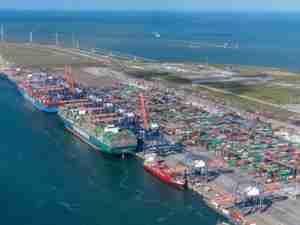The terminal in Neuss will have a surface area of 3 hectares and a capacity of 50,000 to 60,000 teu. Handling operations are due to start in 2009. There is space for expansions of up to 8 hectares and annual throughput of 200,000 teu.
Maersk Benelux director of intermodal, Maarten Tromp, does not rule out investments elsewhere in Germany, for example Bavaria. The Danube ports are also to be included in the intermodal terminal concept.
Maersk wants to increase the modal share of inland shipping and rail. To and from the sea terminal in Rotterdam (*), the percentages are as follows:
| Inland Shipping | Rail | Road | |
| Carrier Haulage | 42 | 32 | 25 |
| Merchant Haulage | 9 | 27 | 65 |
By way of comparison, the percentages for all traffic to/from the Maasvlakte (=APM Rotterdam, the terminal used by Maersk, plus ECT in 2006):
| Maasvlakte | 2006 | 39 | 13 | 48 |
| Maasvlakte/whole Rotterdam | 2035 | 45 | 20 | 35 |
In comparison with other shipping companies, Maersk Line transports a relatively large number of containers in carrier haulage and often makes use of rail (mainly via sister company ERS) and inland shipping. They would like to increase this use even further.
The market share of containers for which transport is arranged by shippers/freight forwarders (merchant haulage) is much greater, however, in the whole of Western Europe. Many (smaller) shippers are located relatively close to the port and therefore use trucks. The Port of Rotterdam Authority is focusing mainly on this target group with its ‘container transferia’
Maersk’s figures are particularly encouraging for the other parties in the chain, but they do not make Rotterdam’s target figures for 2035 any less of a challenge. Even more so as the total container flow is expected to have tripled by then.
(*) For Maersk’s other important West European terminal in Bremerhaven, the percentages for carrier haulage by rail are 64% and by road 35%. For merchant haulage, they are 32% and 68% respectively.










